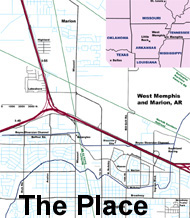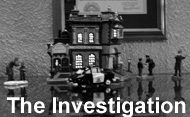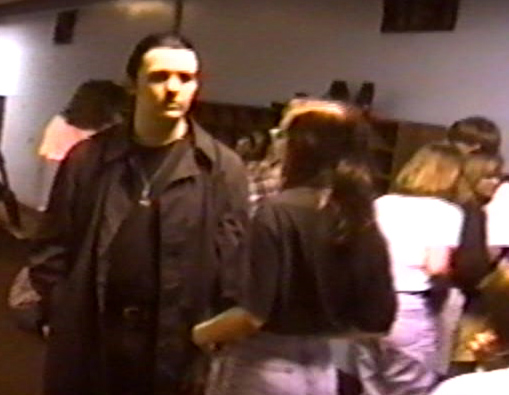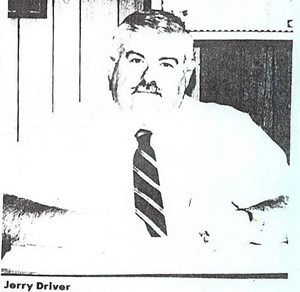
 |
 |
 |
 |
 |
 |  |
 Damien Echols and Domini Teer at the roller rink. Damien Wayne Echols Central to the story of the investigation of the murders of the children is the enigmatic figure of Damien Echols. Eighteen years old at the time, he became a key suspect early in the investigation. He was visited by the police the day after the discovery of the bodies and brought in for questioning on Monday of the following week. He was arrested subsequent to Misskelley's confession, convicted and sentenced to death. He has been on death row for twelve years. Often dressed in black, sometimes sporting provocative self-drawn tattoos or sharpened fingernails, Damien Echols was into heavy metal music and nihilistic poetry. After the case became notorious, he became a cause celebré, and was romanticized as a loner, an outsider, a victim of a small town's demonization of rock and roll. Damien's dress and behavior, his interest in the occult and Wicca, and his love for heavy metal represented to many in the community iconic symbols of the devil. These beliefs are hardly relegated to West Memphis. Recent polls from Gallup and Harris have found six in ten adult Americans believe in the existence of the devil and four in ten believe in demonic possession. Damien played to these fears. He would later described himself as a candidate for the local boogeyman. At least one aspect of this claim was undeserved. Even though he was alleged to have frequented the victims' neighborhood and one would suspect he would have been a memorable presence, he seemed to have gone unnoticed. One of the questions in the door to door interviews asked about suspicious people in the area. Out of the hundreds of interviews, with repeated references to mentally ill neighbors, transients, suspicious vans, a blond kid on a bike, and even John Mark Byers, there was a single reference to someone who perhaps was Damien Echols: ".
. . there used to be a young w/m approx mid-20s straight stringy dark
hair - carried a long staff - slim build was very strange - have not
seen him the last year. . ."
Although not often among the recollections of the neighbors, at least among children, stories circulated around Echols. The police spent considerable time chasing rumors told by children regarding Echols. Those closer to him, knew he had a history of mental illness and hospitalizations. His parole officer, Jerry Driver, was convinced he was part of a satanic group. In contrast, Damien repeatedly stated he followed the Wiccan faith, a pacifist nature-based religion. As Kris Kristofferson said about another man in black: "He's a walking contradiction, partly truth and partly fiction. . ."* Even his name became a matter of controversy, with some believing Damien chose his name after the antichrist character in the Omen films. Born Michael Wayne Hutchison on December 11, 1974, he changed his name to Damien Wayne Echols in his early teens after being adopted by his stepfather Jack Echols, a strict Catholic. He stated at trial he chose the name Damien because he had for a brief period explored Catholicism, and he was fascinated by the saint, Father Damien, who had worked with lepers, eventually becoming infected with the disease. This was confirmed by his father and by his nemesis, Jerry Driver. Driver, a member of the parish, said he spoke with Damien's priest, although Driver intimated that Damien's only interest in the Catholic church was to infiltrate it in order to steal the eucharist for satanic ceremonies. .
. . he [the priest] said that Damien came to church I think he had came
that previous um, that winter or fall and had professed a great
interest in the Catholic religion and um had convented and had his name
changed um, and then had quit coming and he related to me that right
after he quit coming someone tried to broke into the sacristy and he
had always wondered if. . ., if he had anything to do with it, of
course that's one of the things that those guys do that's kinda modus
operandi, their go to the Catholic church and find out as much as they
can, break in to the sacristy, steal the host and the lunette. .
. (Jerry Driver, interview with police, December 1993. Note -
with all quoted documents I have tried to maintain the wording and
spelling of the original documents and will not include the term "sic"
unless a phrase or word seems particularly out of place.)
In the book, Devil's Knot, the author Mara Leveritt, contradicts this claim, saying she spoke to the priest who said there was no attempt to break into the sacristy.  Jerry Driver, 1992. Now serving parole in Florida for grand theft. As part of an extensive interview with the police, Driver stated, ". . .Mr. Echols said to both of us that he was involved in the occult, but not as a devil worshiper as such, he said he was a gray witch." Driver went on to say that Echols, Misskelley, Baldwin and Echol's girlfriend Domini Teer all always denied being involved in Satanism. This didn't prevent Driver from making elaborate claims about Damien. Driver presented nothing to support his charges beyond suspicions, secondhand stories, and interpretations of cryptic comments and scribblings. Probably the most extravagant claim by Driver was that Echols and his girlfriend had planned to have a baby and sacrifice the child to the devil. This was based on the interpretation of a drawing and "confidential informant people."
. . .[Damien] and [ex-girlfriend] Dianna was trying to conceive a child
and that child was to be sacrificed and we. . ., we got that
information from informants and from some drawings that we um, that we
had confiscated from. . ., from Damien at the time and I think you all
have those, uh, one which had four tombstones and a baby's foot from
behind it and a rattle and power emanating up into the moon or
something, and they always denied that, and they always denied that,
they always said no that's not he case, but several people very close
to them, confidential informant people said that's what was going on. .
. (Driver, Dec. 1993)
Driver went on to say that although he had referred his informants on to the police, they told the police different stories. When asked if Driver knew who were the 10 to 15 people in the cult, he says, "I have suspicious you know, and several of them I think we've have already give to you all to talk to um, but they don't say the same things to you all that they say to us." (Driver, Dec. 1993) As odd as these claims were and as shaky as the evidence was to support them, Driver was willing to pass along these accusations. In August of 1992, shortly after Echols had moved with his family to Oregon, supervision of his probation was transferred to the local authorities. The probation officer contacted Jerry Driver and took these notes. Mr. Driver made the folowing comments: a) Damion and several others of his associates are involved in a satanic cult.
b) Damion and his girlfriend were both placed in a psychiatric hospital, in that the two of them had made a suicidal pact with one another. c) Damion threatened to kill his girlfriend's parents. d) Damion claims he is a witch. e) Damion and his girlfriend were planning to have a child, so that they could offer it as a sacrifice to Satan. f) The authorities in Arkansas suspect that Damion's parents are involved in this satanic belief system. (Exhibit 500, p. 467-8) In spite of these inflammatory allegations, the Oregon probation officer recommended minimal supervision. Nevertheless, Damien had demons, although not the kind Driver claimed. Continued in Damien's Demons, Part One *Kris Kristofferson, The Pilgrim, referring to Johnny Cash. Also used to describe Travis Bickle in the film, Taxi Driver. The "Four Tombstones" drawing. Interpreted by Jerry Driver to represent a Satanic sacrifice of Damien's first born. |
![]()
|
Copyright
© 2008 Martin
David Hill
|
|
Site
Design By Michael
Gillen
|